Dispatches from Oxford in the Realm of England
his blog reports the experiences and findings of Dr. Henry Miller while he is on assignment at the Centre for Medieval and Renaissance Studies at Oxford, England. From September 2011 to May of 2012, he will be conducting research about early Maryland and its English connections, writing, and teaching. Watch this space for Dr. Miller’s research findings, insights on the remarkable history and nature of Oxford and other places he visits, and curious aspects of living in another country.
September 24
Oxford is a fascinating city, filled with the ancient and modern, and home of the oldest University in the English-speaking world. While there is no sure date for its beginning, teaching was underway here before 1100, and grew rapidly during the Medieval era. An academic leader called the Chancellor was established here in 1201, and that is the reason many universities in the United States today have a similarly named position. Oxford is definitely older than Cambridge, a source of great pride here. We know this because in 1209, following conflict between the town folk and students, some of the teachers moved to the town of Cambridge to found a new school. Both grew into world class academic institutions and are collectively sometime referred to as Oxbridge. The traditional abbreviation for Oxford in Oxon. The seal of the University of Oxford is seen here and the motto is in Latin – “Dominus Illuminatio Mea” (The Lord is my Light).

This reflects the fact that universities were directly linked to Christianity in their origin, and many religious orders were in Oxford and operated houses for students up until the Reformation.
But do not think that the University of Oxford works similarly to the University of Maryland or other U.S. institutions. The university is actually a consortium of 38 separate colleges and 6 Halls which teach students, and numerous research institutes and museums in association. The University provides a central administration but all Colleges are independent. Even more confusing are the academic Departments. These rest between the colleges and the university, having their own facilities, and their teachers are people from various of the colleges. It can be confusing to decipher this organization. But they do share a number of facilities, especially the great library complex, headed by the Bodleian.
Why does Oxford have any significance for Maryland and St. Mary’s City? The main reason is that the first and second Lords Baltimore (George and Cecil) were educated here, along with most of the university educated persons who came to Maryland. These range from John Lewger, who built St. Johns, and the colony’s first Anglican minister William Wilkinson, to the first Royal governor, Sir Lionel Copley. Later generations of the Calverts in the 18th century continued this tradition, coming to Oxford for education. Oxford had a powerful influence in shaping the ideas and perspectives of Maryland’s founders and later leaders. This is a topic that we will be exploring in greater detail later.
One of the things I find it necessary to do here is recalibrate my sense of scale. Growing up in the United States, one develops a certain sense of space that is rather large in scale. England is different. Despite being one of the most densely populated countries in Europe, with about 60 million residents, it is actually a rather small landmass. Oxford is located in the south central portion and from it, one could reach most places in England in about the time it would take you to drive to Norfolk or Philadelphia from St. Mary’s City. What looks a long way on the map is often only a few hours. This is a factor that has historical resonance because land is in limited supply. The importance of land, the value placed on its ownership and prestige deriving from its possession is an ancient component of English heritage. One need only think of the Manorial Lords and their tenants, grateful for a small amount of acreage to farm. Considering this attitude, and the nature of life in 17th-century England, the opportunity to have your own 50 acres of land in Maryland becomes a more understandable and stronger motivation for someone, making the risks of migration to the colony worth it.
Another related subject is rivers. When I think of a river, they are large, wide bodies of water like the Mississippi, Arkansas, Potomac or Susquehanna. While some of the rivers in England do widen as they approach the ocean, as the Thames at London or the Severn at Bristol, most are far smaller, and would be what we tend to call creeks, or if you are from certain latitudes, cricks. Some examples are the Thames at Oxford
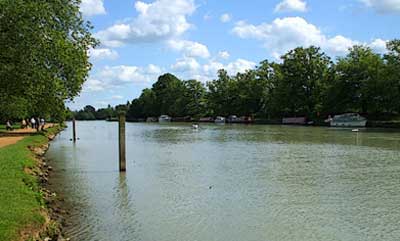
and the River Avon at the town of Warwick .
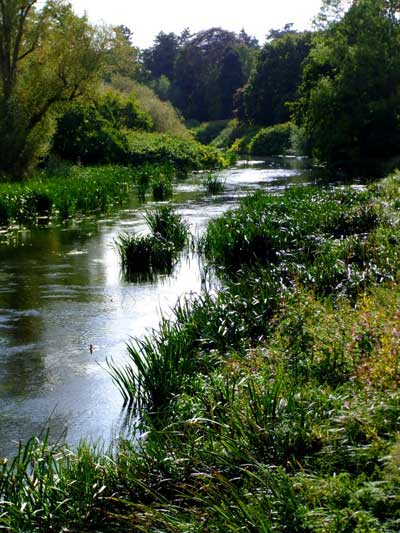
Avon also flows past Stratford-on-Avon, home of Shakespeare. It is not wide, but richly vegetated and swift flowing, with schools of fish visible in the clear sparkling water. One of its numerous inhabitants is the graceful swan.
A field trip with the CMRS students to the small town of Warwick allowed the opportunity to visit this venerable community, located about 50 miles from Oxford and 12 from Stratford-on-Avon. Its most famous site is Warwick Castle (begun 1350s), one of the most well preserved medieval castles in England.
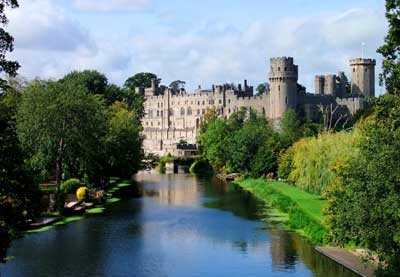
The major reason for its preservation is that, although besieged in the English Civil War, it was a parliamentary stronghold. When Oliver Cromwell ordered the defenses of most castles throughout England to be permanently weakened so they could no longer be used by Royalists, Warwick was in the hands of a parliamentary supporter and thus, escaped any demolition. It is an impressive stone edifice, now operated as a major tourist attraction.
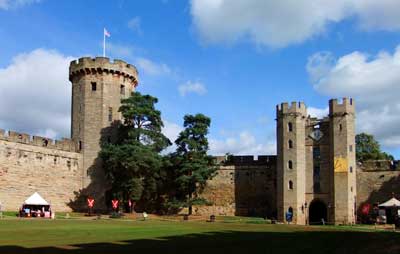
But the town of Warwick is what captured my interest. In 1694, the same year the legislature voted to move the capital from St. Mary’s City, a fire gutted the core of this settlement. Fortunately, numerous 15th, 16th and 17th-century structures survived around the edges. This area was dominated by what is called Half-Timber Architecture. After the frame was assembled, workers filled the spaces between the timbers with clay, brick or other materials, and finished the walls with a protective layer of stucco. Most tend to date between the 1450s and 1690 here. Originally mostly covered with thatch, the small fire rapidly spread and consumed hundreds of buildings. But the survivors are fascinating. Here is a street that was untouched by the disastrous conflagration.

Soon afterward, an ordinance was passed that no one could use thatch in Warwick, and roofs are now mostly clay tile or slate.
One of the oldest building complexes is called Lord Leycester’s Hospital.
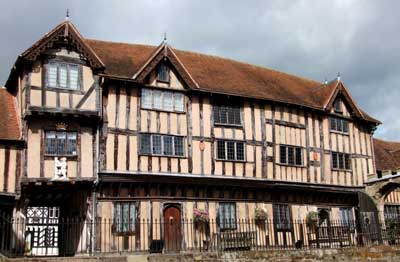
Begun in the 1460s as the Guild offices, it became a home for old and disabled soldiers in 1571 and continues in that use to this day, 440 years later. It never served as a medical facility, but provided “hospitality” to the needy. The residents are known as the Brethren, all retired British military. This picture of the current group shows their formal dress and military medals.
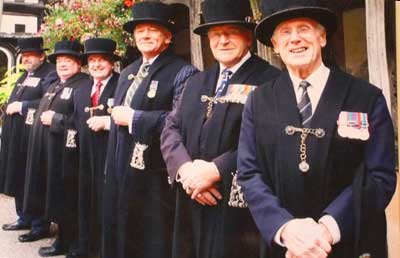
The gentleman on the right was operating the gift shop and I had a delightful conversation with him about the place and the experience of living there. One connection to us is that in 1617, King James made a state visit to Warwick and dined in this structure, perhaps accompanied by the rising George Calvert. The visit was well remembered by the people of Warwick, in part because it took them 10 years to pay off the costs of hosting his royal presence.
English housewrights could produce remarkably attractive decorative structures by using the wood and infill in creative patterns.
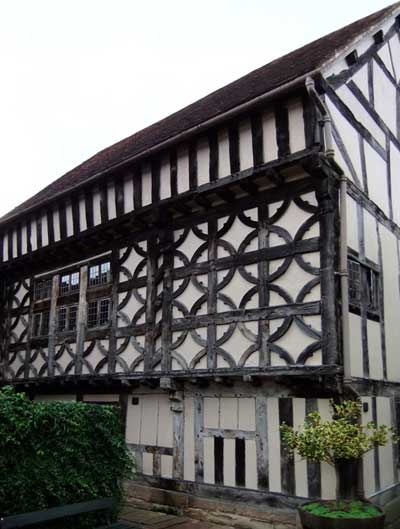
This method of construction was prominent in some areas of England in late medieval and early modern times. A nearby street corner contains another superb two story example of the type.
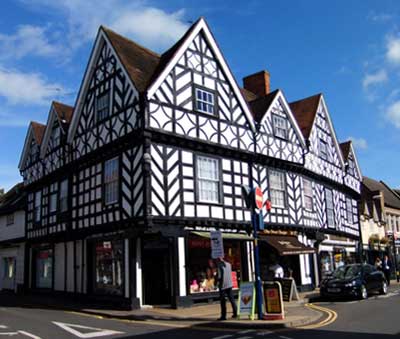
Maryland settlers were definitely familiar with this type of architecture and it is possible that some built in this manner in the early years of settlement. However, half timber construction is in part a response to the shortage of timber, a major problem that grew in severity in England. Early Maryland had excellent timber in abundance and it therefore seems unlikely half timber construction was widely used in the colony. But it is nevertheless useful to know about this type because it was one of the available architectural models that settlers carried with them in their minds, and it could have been employed in Maryland.


